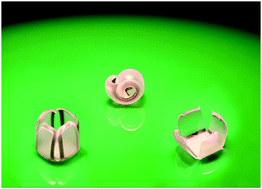Controllable curvature from planar polymer sheets in response to light†
Abstract
The ability to change shape and control curvature in 3D structures starting from planar sheets can aid in assembly and add functionality to an object. Herein, we convert planar sheets of shape memory polymers (SMPs) into 3D objects with controllable curvature by dictating where the sheets shrink. Ink patterned on the surface of the sheet absorbs infrared (IR) light, resulting in localized heating, and the material shrinks locally wherever the temperature exceeds the activation temperature, Ta. We introduce two different mechanisms for controlling curvature within SMP sheets. The ‘direct’ mechanism uses localized shrinkage to induce curvature only in regions patterned with ink. The ‘indirect’ mechanism uses localized shrinkage in regions patterned with ink to induce curvature in neighboring regions without ink through a balance of internal stresses. Finite element analysis predicts the final shape of the polymer sheets with excellent qualitative agreement with experimental studies. Results from this study show that curvature can be controlled by the distribution and darkness of the ink pattern on the polymer sheet. Additionally, we utilize the direct and indirect curvature mechanisms to demonstrate the formation and actuation of gripper devices, which represent the potential utility of this approach.



 Please wait while we load your content...
Please wait while we load your content...